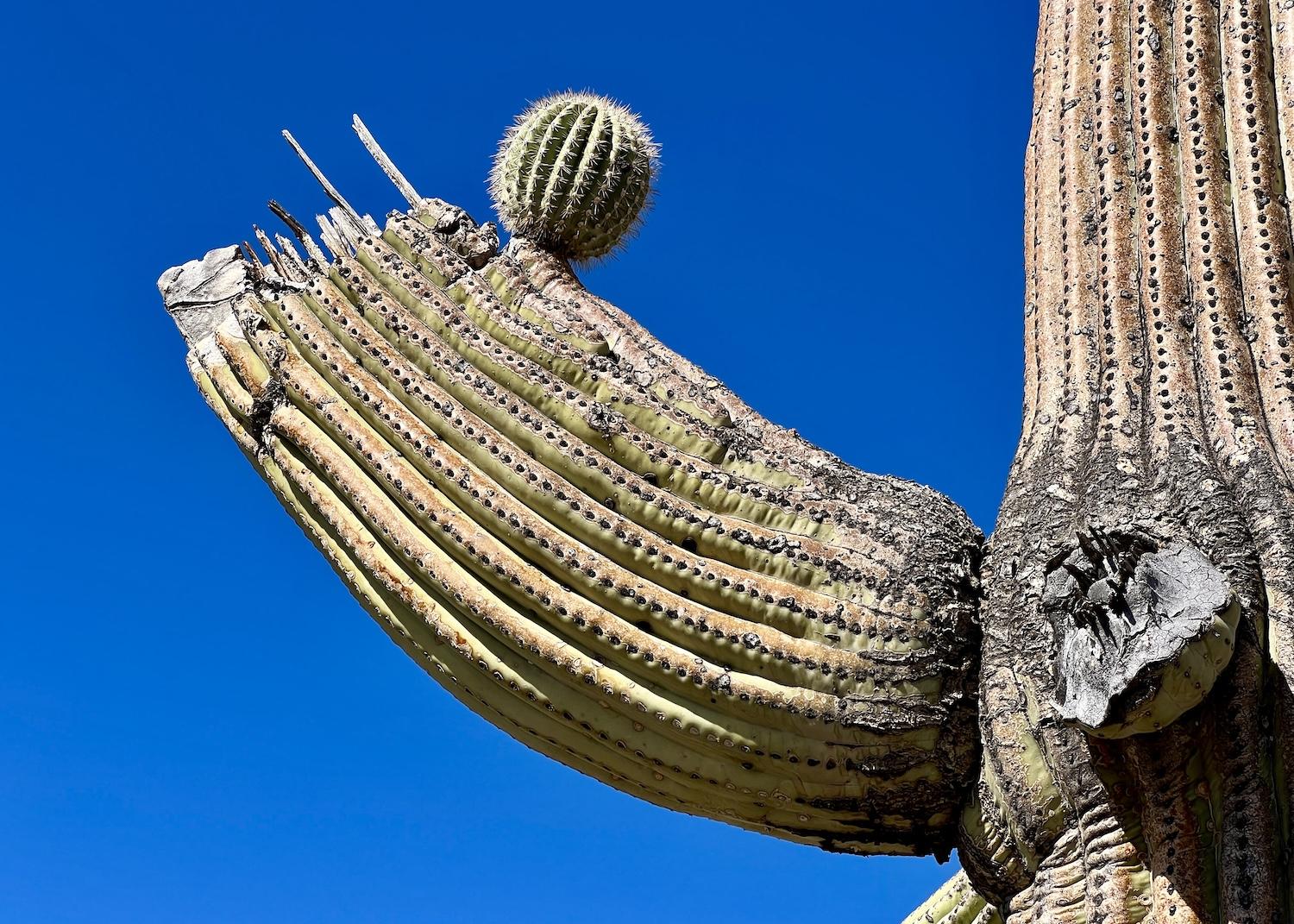
Along the Desert Discovery Nature Trail in Saguaro National Park's west district, a saguaro grows a new arm off a broken arm/Jennifer Bain
There’s a four-armed saguaro living on the western edge of Tucson that has one broken arm, one newborn arm, one thick older arm pointing to the Arizona sky and one slender younger arm pointing towards the Sonoran Desert soil.
It’s not the prettiest, greenest or healthiest-looking cactus around. But of all the cacti I admired in Saguaro National Park, it’s the one that made the biggest impression.
I wondered what Don Swann would say about it. He’s the park biologist in charge of a Saguaro Arms Citizen Science Project that launched last March and runs to April. He realized that saguaros may be America’s largest cactus and the icons of the southwest, but little is known about their massive branches (aka arms) that can produce the flowers and seeds needed for reproduction. The more arms there are, the better the chances are that a seed will take root and become a beautiful new saguaro.
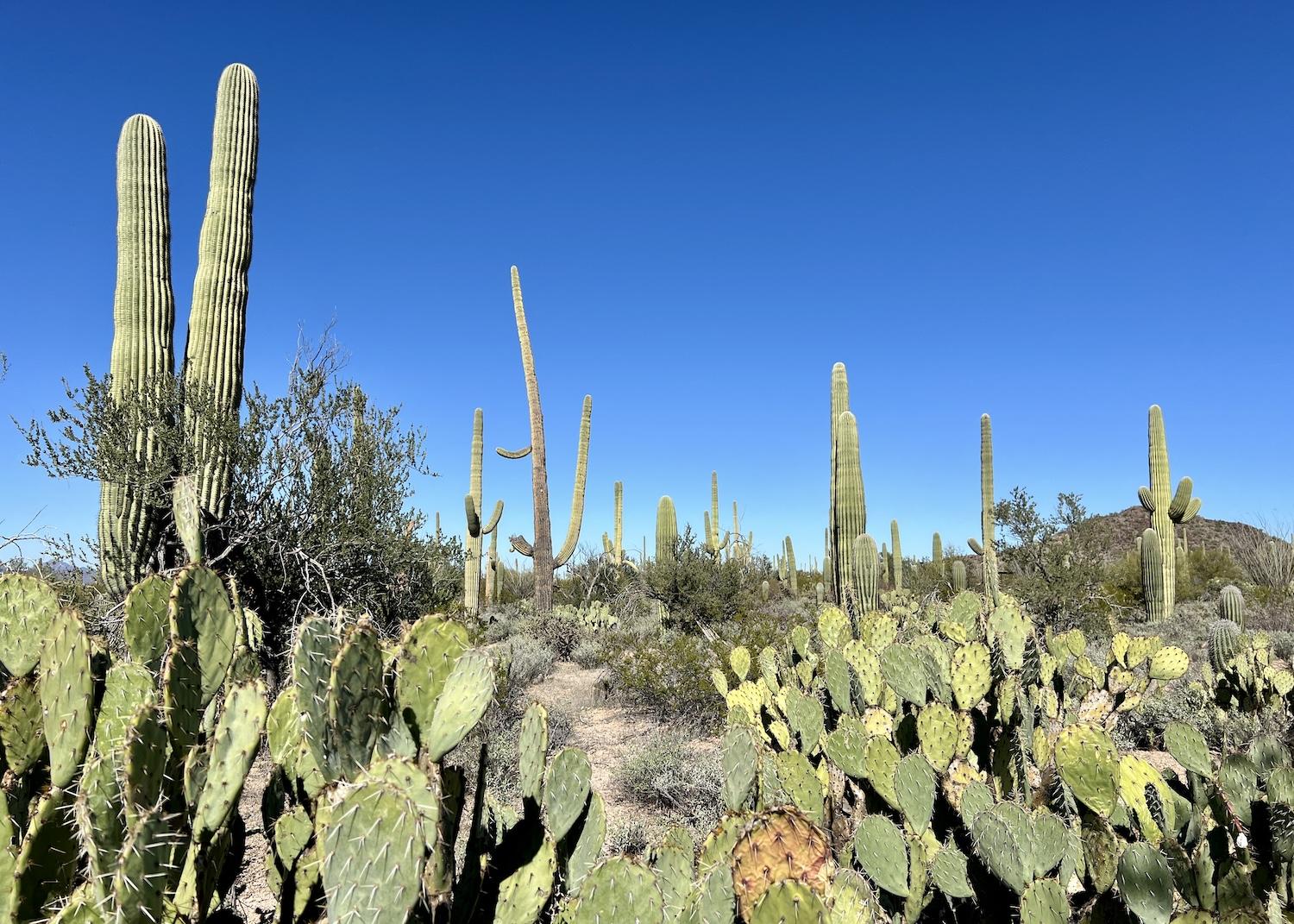
Along the Desert Discovery Nature Trail in Saguaro National Park's west district, prickly pear cactus co-exist with human-like saguaro cactus in the green desert/Jennifer Bain
Using extendable measuring poles and compasses, Swann and his volunteers are studying the growth and symmetry of saguaro arms. They hope to answer popular visitor questions like “do saguaros grow their arms symmetrically” and “how tall does a saguaro have to be before growing its first arm” and “do saguaros grow their first arms facing a certain direction?”
The team has already collected data on hundreds of saguaros — all found off park trails — and hopes to research hundreds more.
The working theory is that saguaros start their branching at a certain size, not a certain age. Initial data indicates that saguaros tend to grow their first arm facing the south or southeast, often when they’re around 11-feet tall. Second arms often grow facing north. Arms seem to grow in a way that maintains symmetry and allows the saguaro to keep its balance.
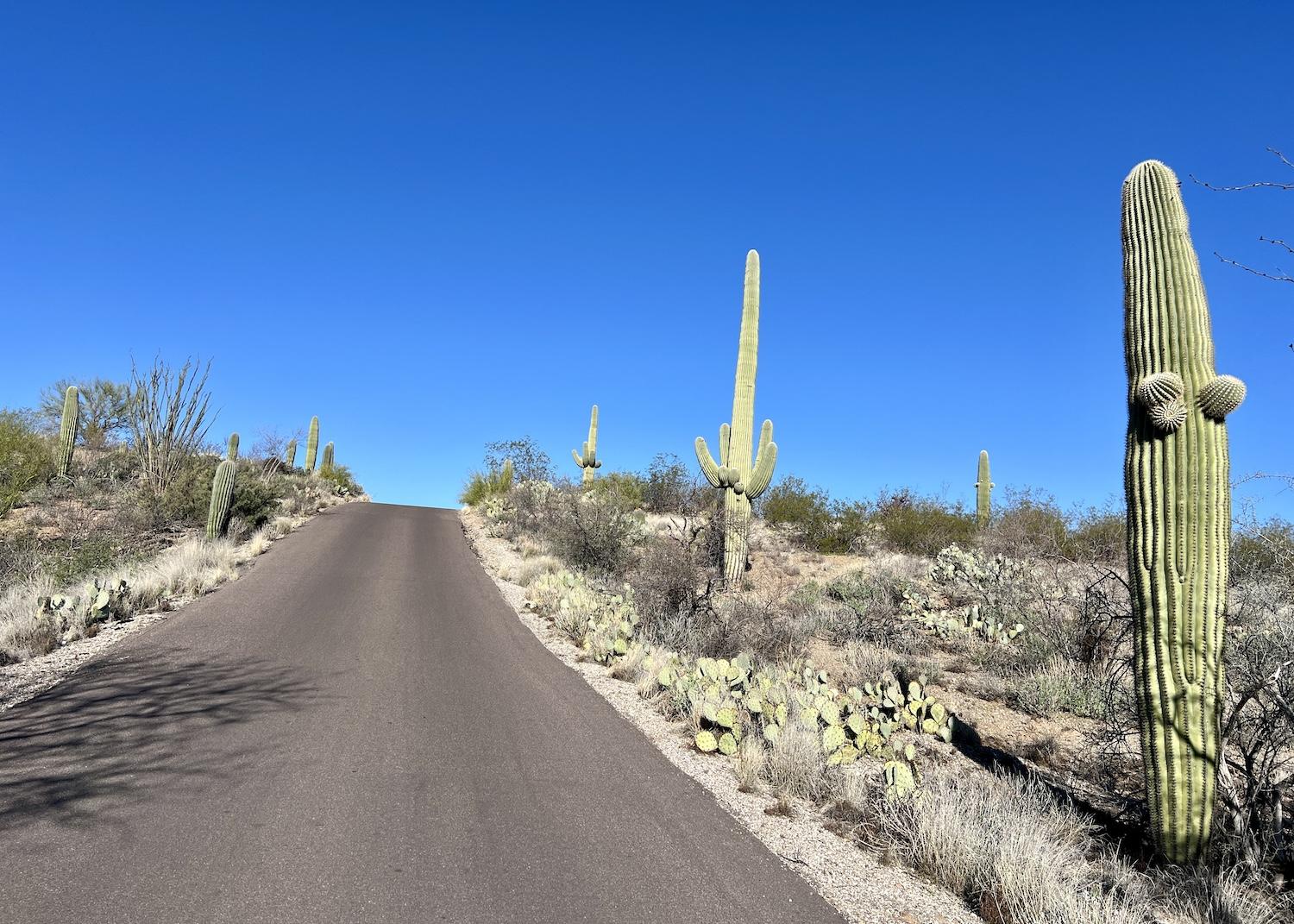
Driving down Cactus Forest Drive in Saguaro National Park's east district, you'll see a multitude of saguaros/Jennifer Bain
I traveled from Toronto to Tucson for four nights in February to celebrate Saguaro National Park’s recent certification from DarkSky International as an Urban Night Sky Place, but also to get to know its namesake cactus.
The park protects more than 94,000 acres of Sonoran Desert habitat in two separate units — the Rincon Mountain District in the east and the Tucson Mountain District in the west — that flank the city. It also protects two million saguaros (Carnegiea gigantea), which are named after industrialist/philanthropist Andrew Carnegie to honor his support for the 1903 establishment of the Desert Botanical Laboratory (now the Desert Laboratory on Tumamoc Hill) in Tucson.
The iconic plant — whose name is pronounced with some variation on suh-waa-row or sa-WAH-ro — needs very specific conditions to reproduce and doesn’t do well with highly variable or extreme weather.
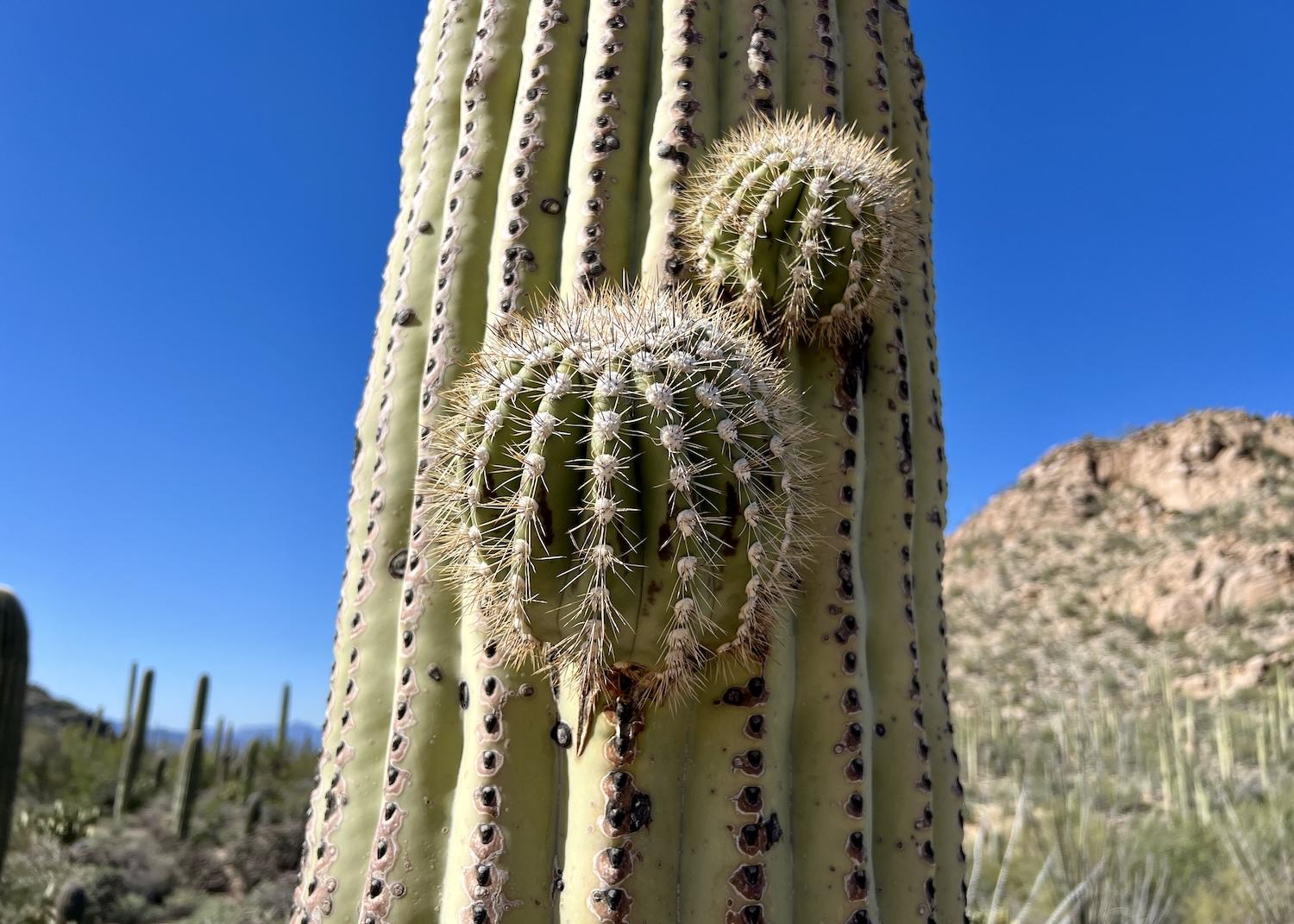
Young, healthy arms start to grow off a saguaro cactus in Saguaro National Park in Tucson/Jennifer Bain
I didn't get to volunteer with the Saguaro Arms Citizen Science Project, but learned what I could, where I could about the green giants that famously resemble humans thanks to their tall frames and arms.
Saguaros aren’t endangered, but only live in parts of the Sonoran Desert in southern Arizona and western Sonora, Mexico with a few stray plants in southeast California. The slow-growing columnar cacti can live to 200, grow to 60 feet and swell to 4,800 pounds. They don't have yearly rings like trees so it's tough to determine their exact ages.
Of course, saguaros face multiple threats. During an Aug. 22 “blowdown event” in the park's west district, about 1,200 were knocked over, lost arms or had their tops sheared off during the storm. Drought has been a problem since the mid-1990s and has prevented young saguaro from thriving. Cactus poachers have been caught and prosecuted. The park is currently tackling invasive buffelgrass and has set up boot brush stations at trailheads to curtail spread.
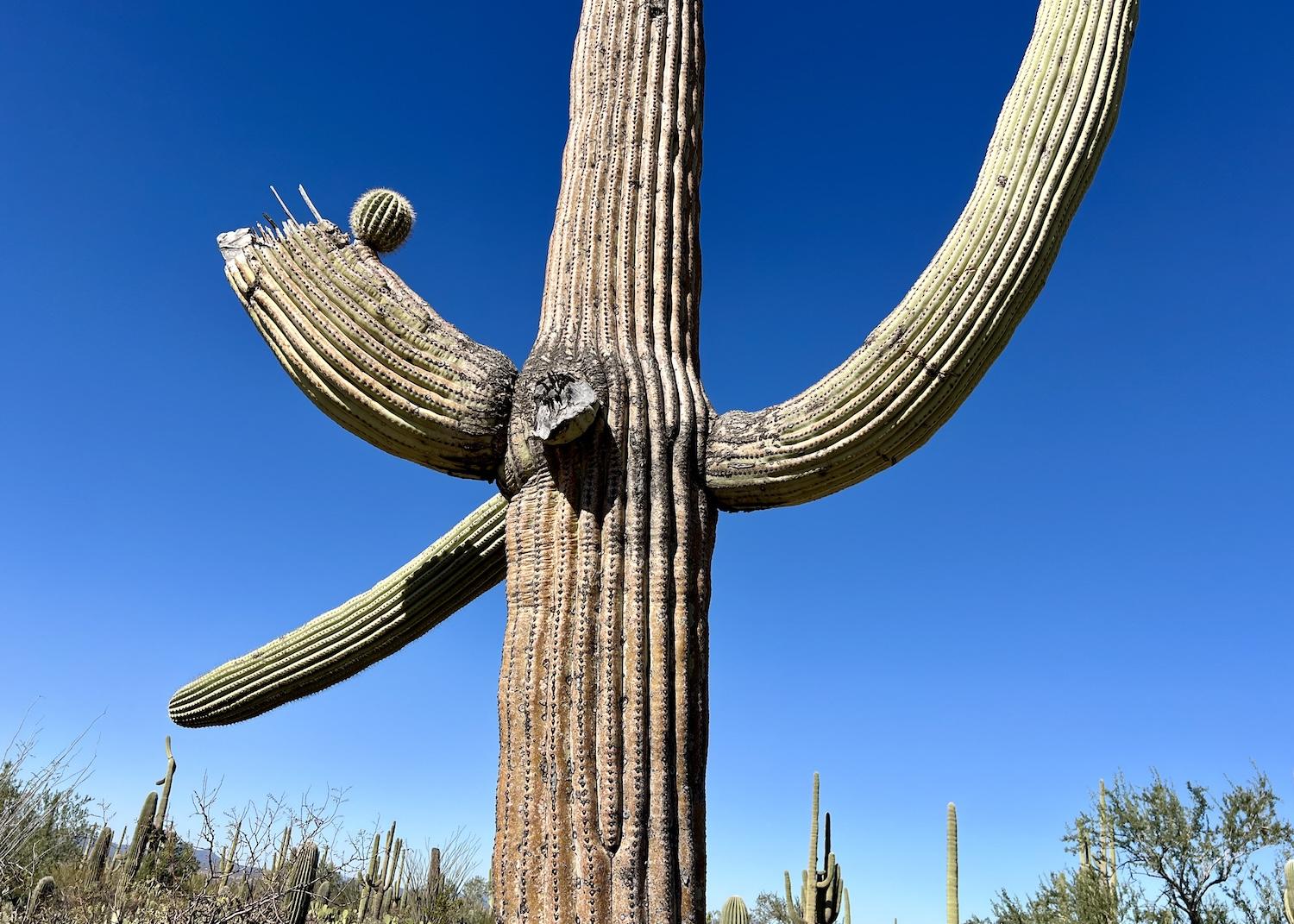
This memorable four-armed saguaro in Saguaro National Park's west district has old, young, broken and new arms/Jennifer Bain
As for my four-armed favorite, which stands along the Desert Discovery Nature Trail, Swann had this to say when I shared a photo: “I see a survivor. They are extremely resilient plants that can take a lot of things that nature throws at them.”
The golden-brown patches on it are called "epidermal browning" and are common in older saguaros. Evidence suggests it's a "mainly harmless" kind of sunburn," said Swann, "but the saguaro can't photosynthesize in this area, which is fine because there is plenty of green elsewhere."
The arm that points up is normal. The arm that points down was probably damaged in a past freeze event, likely in the 1970s or earlier. Saguaros can tolerate frost but are often damaged during freezing events that last 36 hours or more. The broken arm may have happened in a wind event, like the one that from last August with heavy rains and very extreme winds. Swann believes this cactus has a scar where it completely lost an arm. As for the tiny arm, Swann often calls these "nubbins" if they're softball-sized or smaller.
"This saguaro is actively growing and going strong," the biologist concluded. "Saguaros add arms so they can increase their reproductive potential, because the flowers (and then the fruit and seeds) are produced at the growing tip of the main stem and each arm. If the saguaro is doing okay, it will put its energy into producing arms so it can increase its reproductive potential."
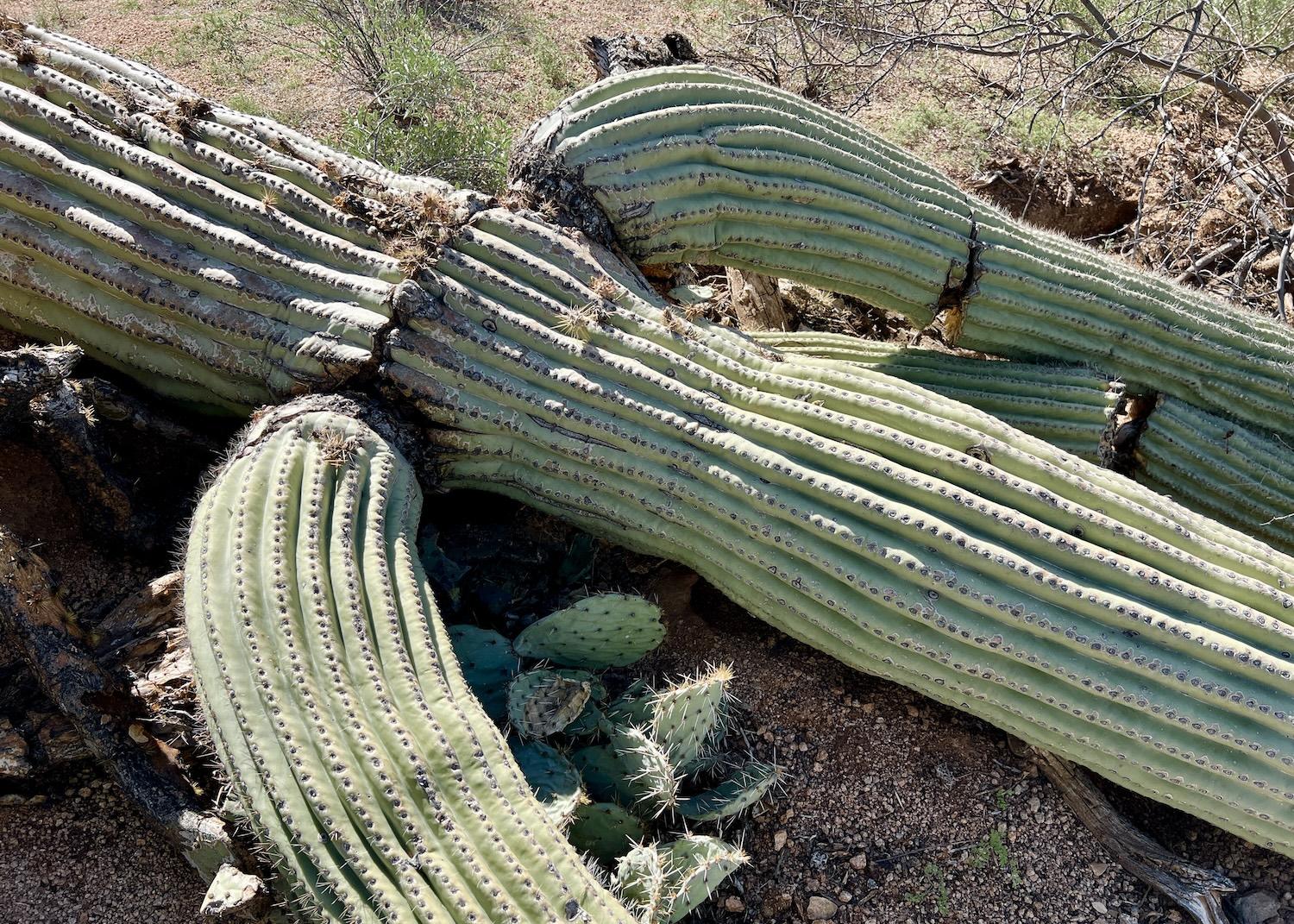
A fallen saguaro cactus is spotted in Saguaro National Park's west district, where an August 2023 blowdown event killed or maimed about 1,200 cacti/Jennifer Bain.
So all bodes well for my favorite, albeit decrepit-looking, saguaro.
The park's arm research, meanwhile, will soon wrap up with a report and peer-reviewed scientific paper. The team hopes to be able to revisit the saguaros it studies to better document the growth rate of arms as well as actual events such as lost arms and arms turning downward.
Swann has been working at the national park since 1993 and actively studying saguaros since 2010. "I find them to be beautiful, fascinating plants," he said. "The fact they live so long — longer than we do — means that to understand them we must learn about them from previous generations of people, and pass our knowledge on to the next generation."
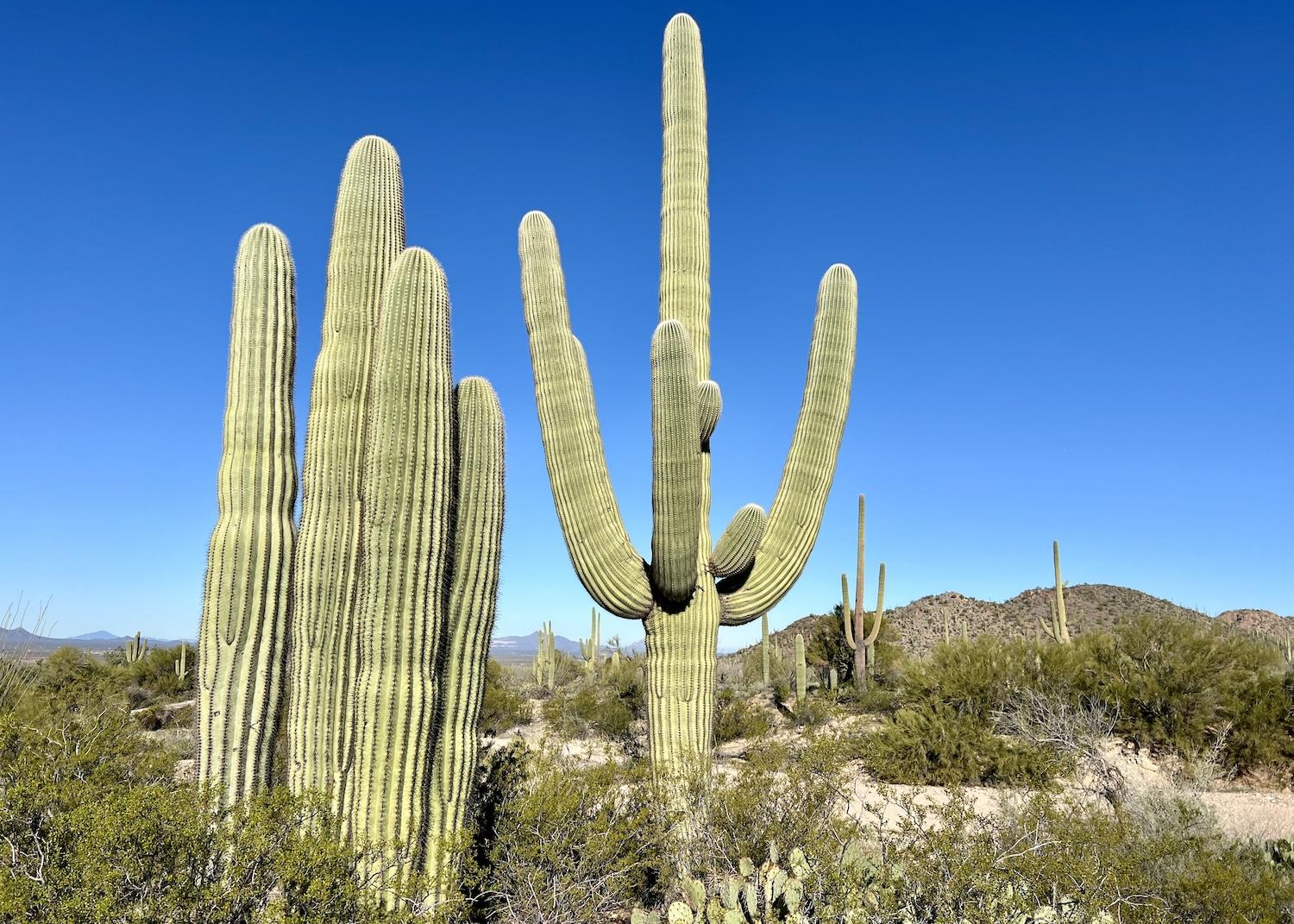
A healthy-looking cluster of vibrant green saguaros, one with arms, others awaiting arms/Jennifer Bain
Another place I visited to learn more about saguaros was the Arizona-Sonora Desert Museum, just minutes from the park’s Red Hills Visitor Center in the west district. “Museum” isn’t the right word for something that’s mainly outdoors and is equal parts natural history museum, zoo, botanical garden, aquarium, art gallery, restaurant and gift shop.
Saguaros are showcased in a cactus garden and on the Desert Loop Trail, and it's here that I read about how they’re covered with protective spines, flowers in the late spring and fruit in summer.
The flowers bloom for less than 24 hours, opening at night and remaining open through the next day. The white flowers are pollinated at night by the lesser long-nosed and Mexican long-tongued bats, and during the day by bees and birds such as the white-winged dove. Pollinated flowers mature into bright red fruit that’s full of juicy red pulp and thousands of small black seeds. The Tohono O’odham people have always harvested the fruit. Desert animals love it, too.
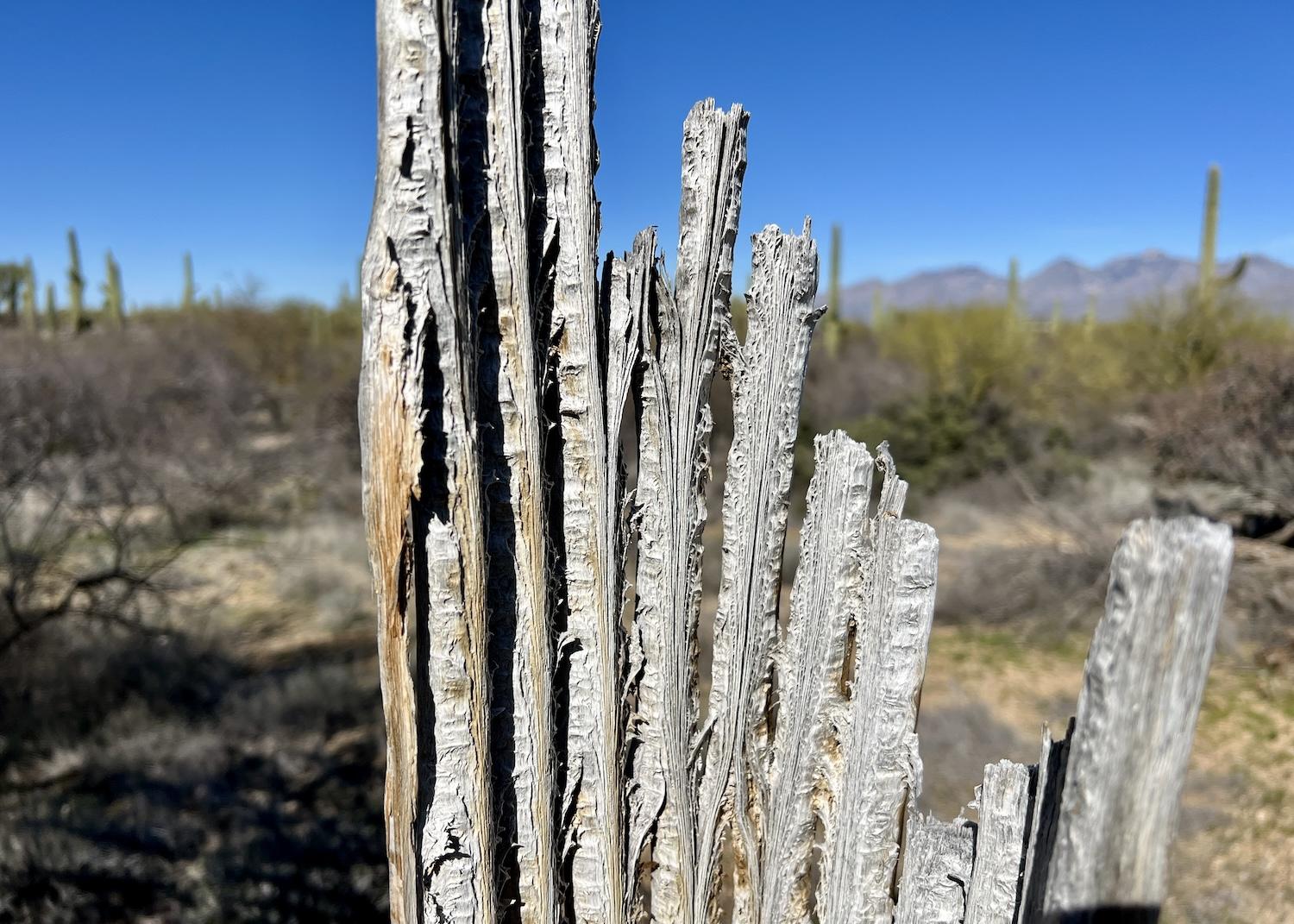
The woody ribs of a saguaro are like cactus "bones" and help it to grow tall/Jennifer Bain
The woody ribs of dead saguaros can be used to build roofs, fences and furniture. Saguaro “boots” — the holes that birds nest in — were once used by Indigenous Americans as water containers once the cactus died. Saguaros need to grow under a protective nurse plant or tree at first. Eventually, they provide food, water and shelter for many desert creatures.
Over in the national park’s visitor center, a short introductory film calls saguaros “fascinating in fact, mysterious in spirit” and delves into the Tohono O’odham Nation’s deep connection to the cactus it considers a relative. “If you understand that the desert is you and you are the desert, you can only ask yourself how would I want to be treated,” one man explains in the film.
It was here that I resisted a plush toy named Sunny the Saguaro, who has two flowering arms and who serves as the park's mascot. But I did support the Western National Parks Association gift shop by buying saguaro earrings. This place — established amid fears about development and grazing — has been a national monument since 1933 and a national park since 1994.
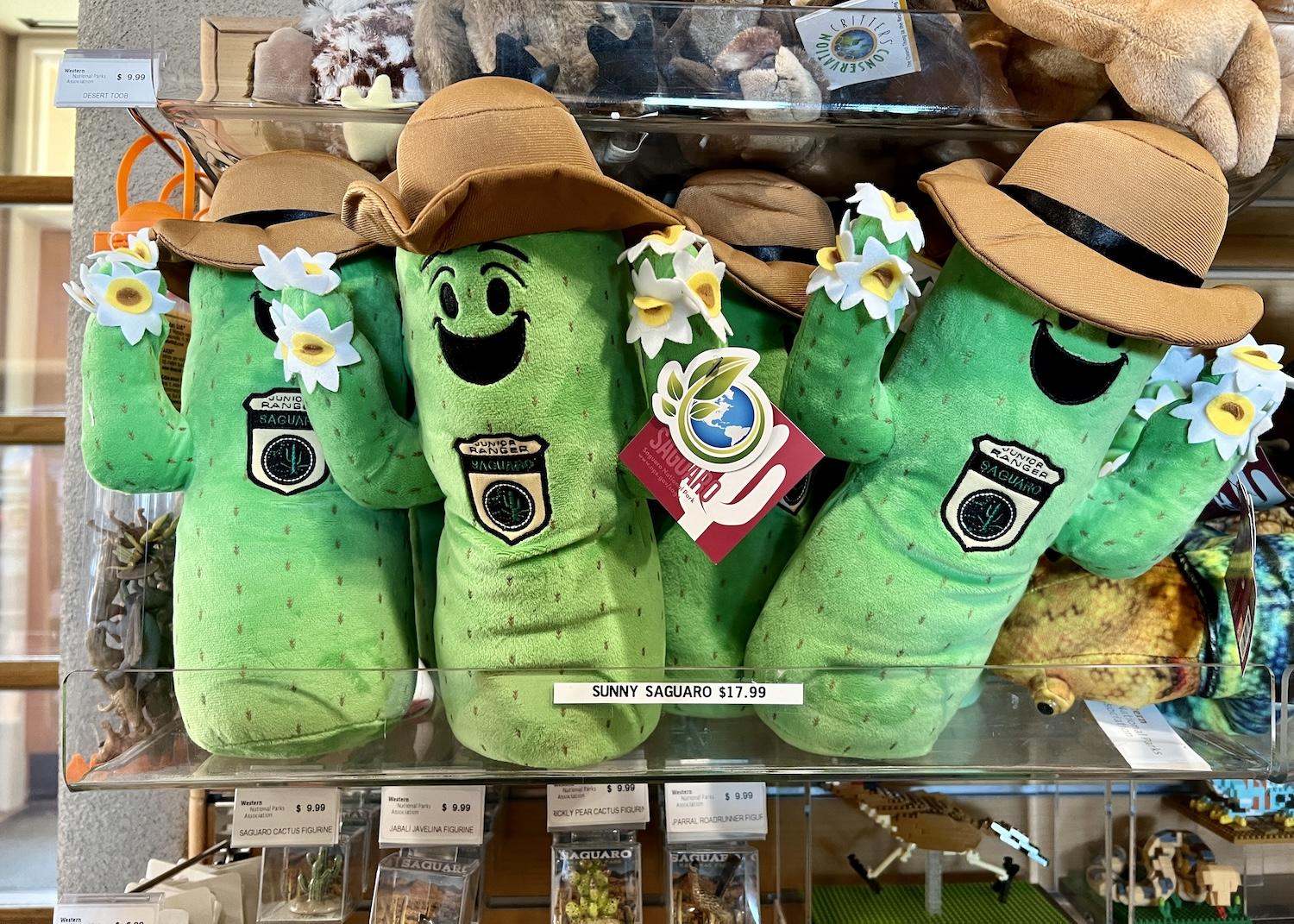
Sunny the Saguaro is Saguaro National Park's mascot and also comes as a plush toy with two flowering arms/Jennifer Bain
Spencer Burke, a district interpretive ranger, doesn’t have a favorite saguaro but confided that he’s 35 years old and about six-feet tall — and that a six-foot-tall saguaro would also be about 35. The park doesn’t have anything like Shiva the 80-arm saguaro that’s found nearby in Ironwood Forest National Monument and was named for a multi-armed Hindu deity.
“The park service is loath to anthropomorphize things and I’d say we don’t have a star attraction saguaro out here,” Burke told me. “And in fact, I think one thing I love about saguaros, and many other people do too, is that they are so unique. You stand back and you just see this forest of saguaros, but then you start walking amongst them and every one is different. They have a lot of personality. They are easy to anthropomorphize.”
Burke believes that when we pick favorite saguaros, “it usually has something to do with the personality we see in its arms.”
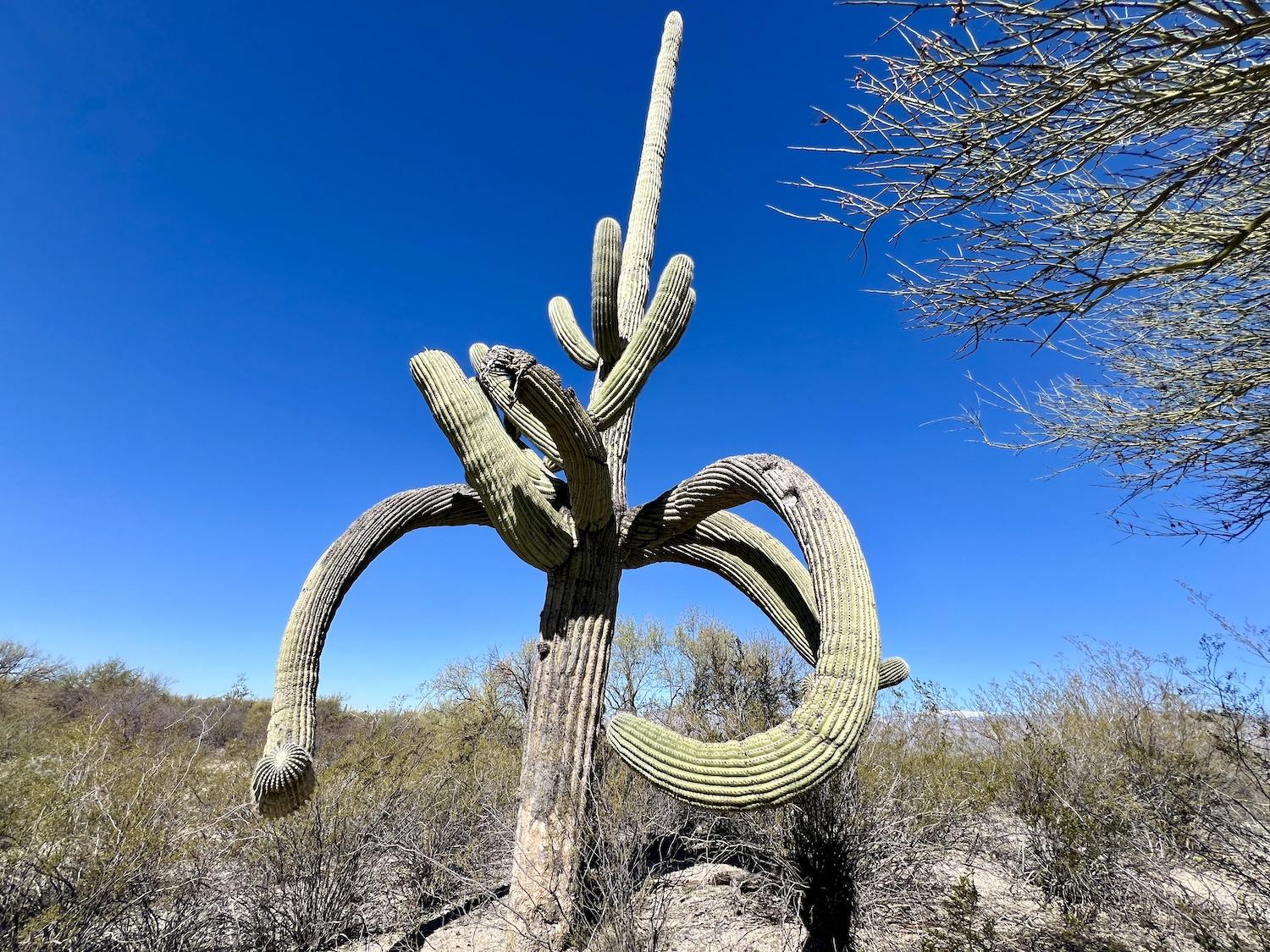
This gnarly saguaro seems to have 13 arms and stands near the junction of Cactus Forest, Cholla and Mica View trails in the park's east district /Jennifer Bain
I found myself projecting personalities on to saguaros during a two-hour morning walk called “A Hike Through the Cactus Forest." As seven of us followed the east district trail, volunteer Diane Taylor celebrated all the cacti, but talked a lot about saguaro arms.
“It goes from nibs to nubs to arms,” Taylor said, pointing out a newborn arm.
"That one's probably 200 years old," she said of an aging, multi-armed saguaro. "That's probaly wind damage and sand damage. Yeah, his color isn't very green."
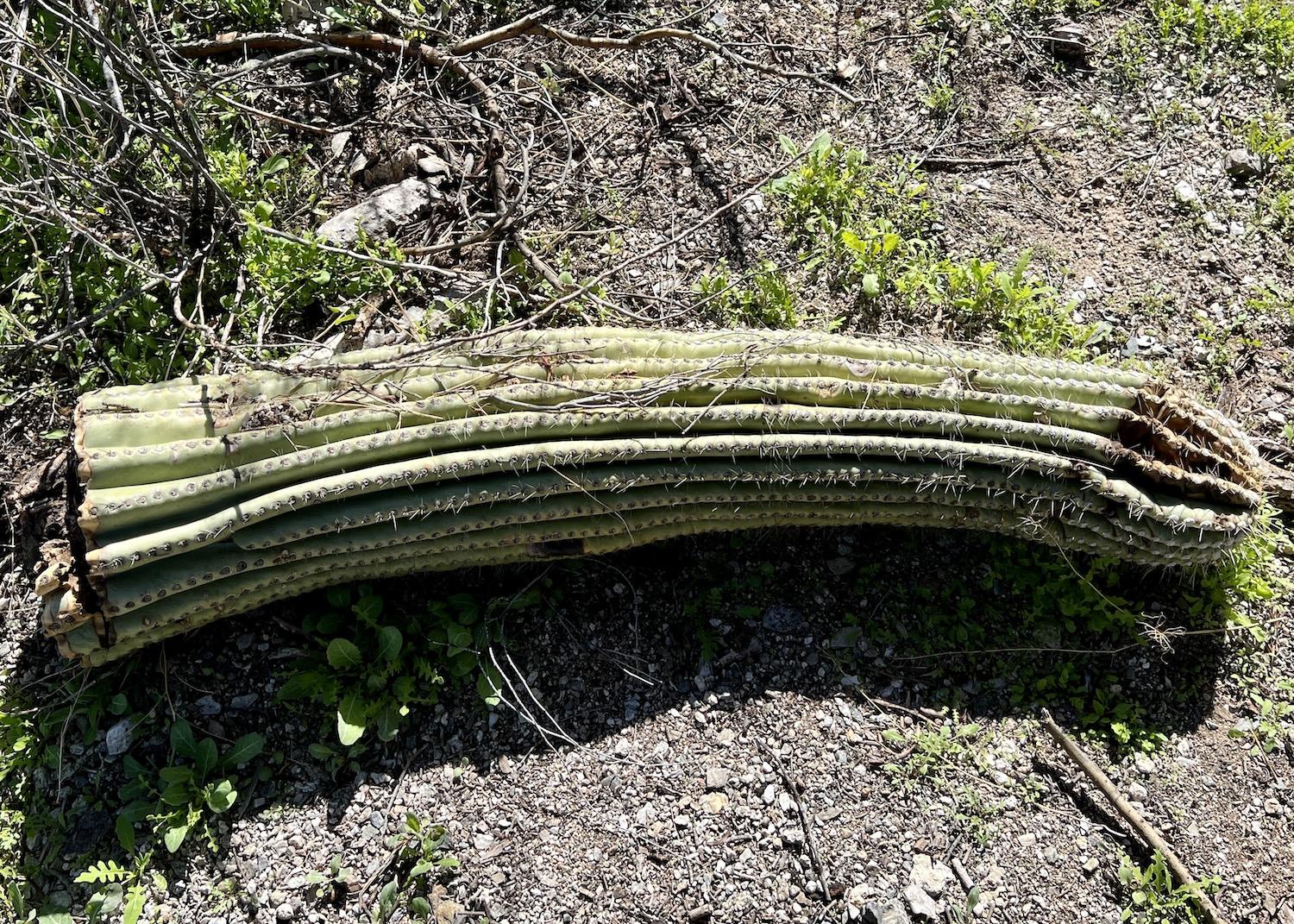
A saguaro arm lies along Cactus Forest in Saguaro National Park's east district, slowly decomposing/Jennifer Bain
“Oh, there’s an example of arms growing down and around,” our guide said of one gnarly saguaro that looked like it was hugging the air. “Whether that’s a growth mutation, physical damage or that’s what the saguaro wanted to do, I don’t know.”
We stopped to take photos of a 13-arm saguaro where the Cactus Forest, Cholla and Mica View trails meet. We lingered by several fallen arms decomposing on the desert floor. We shook our heads at a graffiti-marred saguaro. We celebrated one saguaro that miraculously survived a lightning strike.
Like everyone who is drawn to this park — either to hike among the saguaros or view them on scenic driving loops — we couldn't get over how each saguaro really does exude a unique personality.
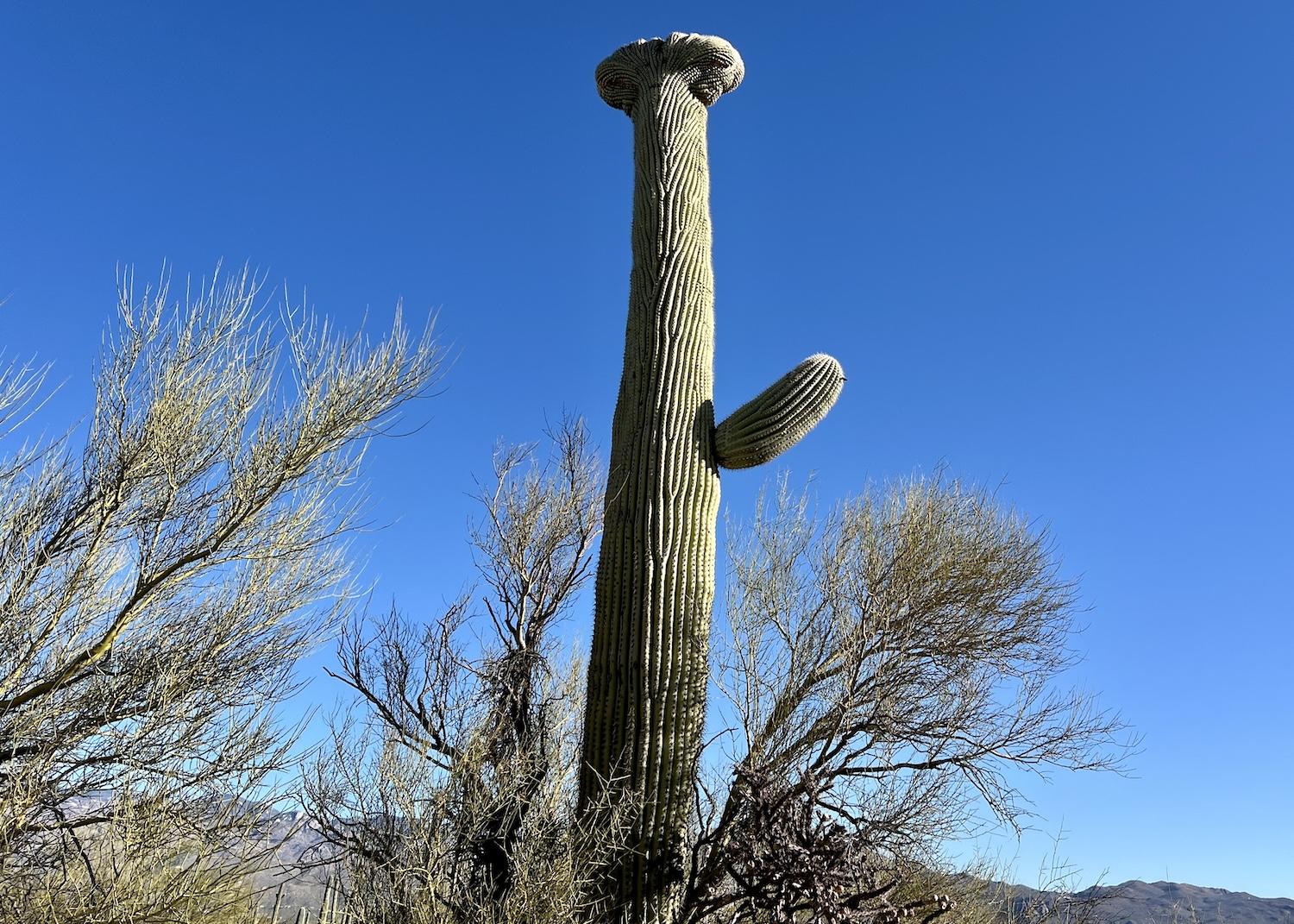
A one-armed crested (cristate) saguaro in Saguaro National Park's east district looks like ET/Jennifer Bain
Steps from the Mica View Picnic Area washroom, we gathered around a crested or cristate saguaro that was topped by something that looks like broccoli, a fan or a semi-circle.
At least 75 of these strange saguaros live in the park, with fan-shaped crests forming at the growing tip of their main stems or arms. Nobody knows what causes this mutation, only that it happens when the cells in the growing stem divide outward instead of in the circular pattern of a normal cactus.
“This cristate saguaro looks like ET on the top,” said Taylor and once I saw it that way I couldn't unsee it. Now I’ll forever think of the lovable extraterrestrial when I see these mutated cacti. This one, though, also had a small, sweet arm that waved us over for a visit and then waved goodbye when we wandered off in search of the next saguaro.
Saguaros Around Tucson
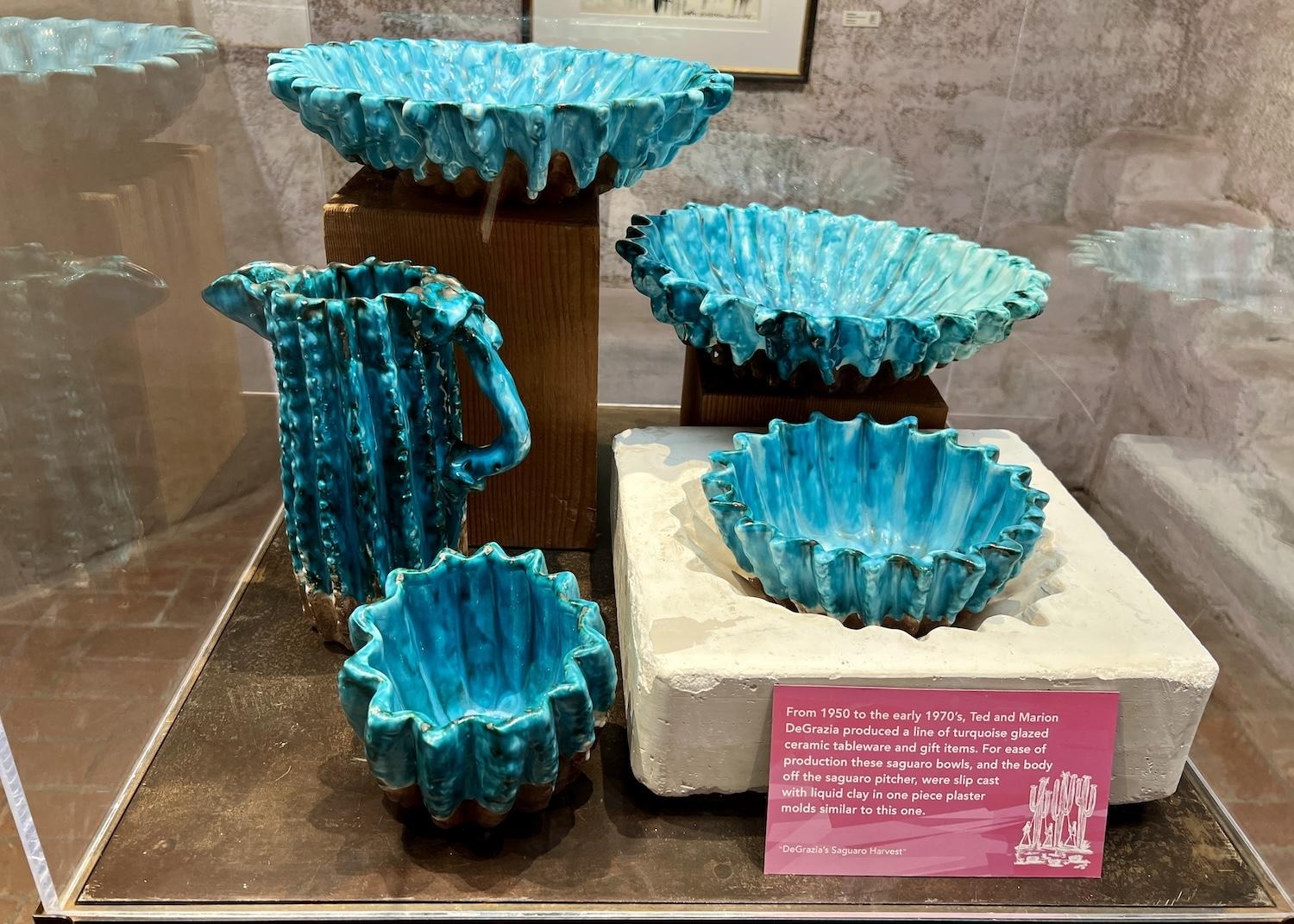
At DeGrazia Gallery in the Sun Museum, artist Ted DeGrazia's vintage ceramic bowls and pitcher were shaped using saguaro pieces/Jennifer Bain
As I criss-crossed Tucson, looping between my hotel and Saguaro National Park’s west and east districts, I saw saguaros everywhere.
Arizona licence plates feature them. Businesses build around them or need permits to move them. Homeowners take care of them. Ethical consumers buy them at reputable garden stores, like B&B Cactus Farm, where knee-sized saguaros sell for $9 an inch.
At the DeGrazia Gallery in the Sun Museum, a 10-acre national historic district, executive director Lance Laber showed me vintage ceramic saguaro bowls with the late artist Ted DeGrazia’s signature turquoise glaze that were slip cast in one-piece plaster molds.
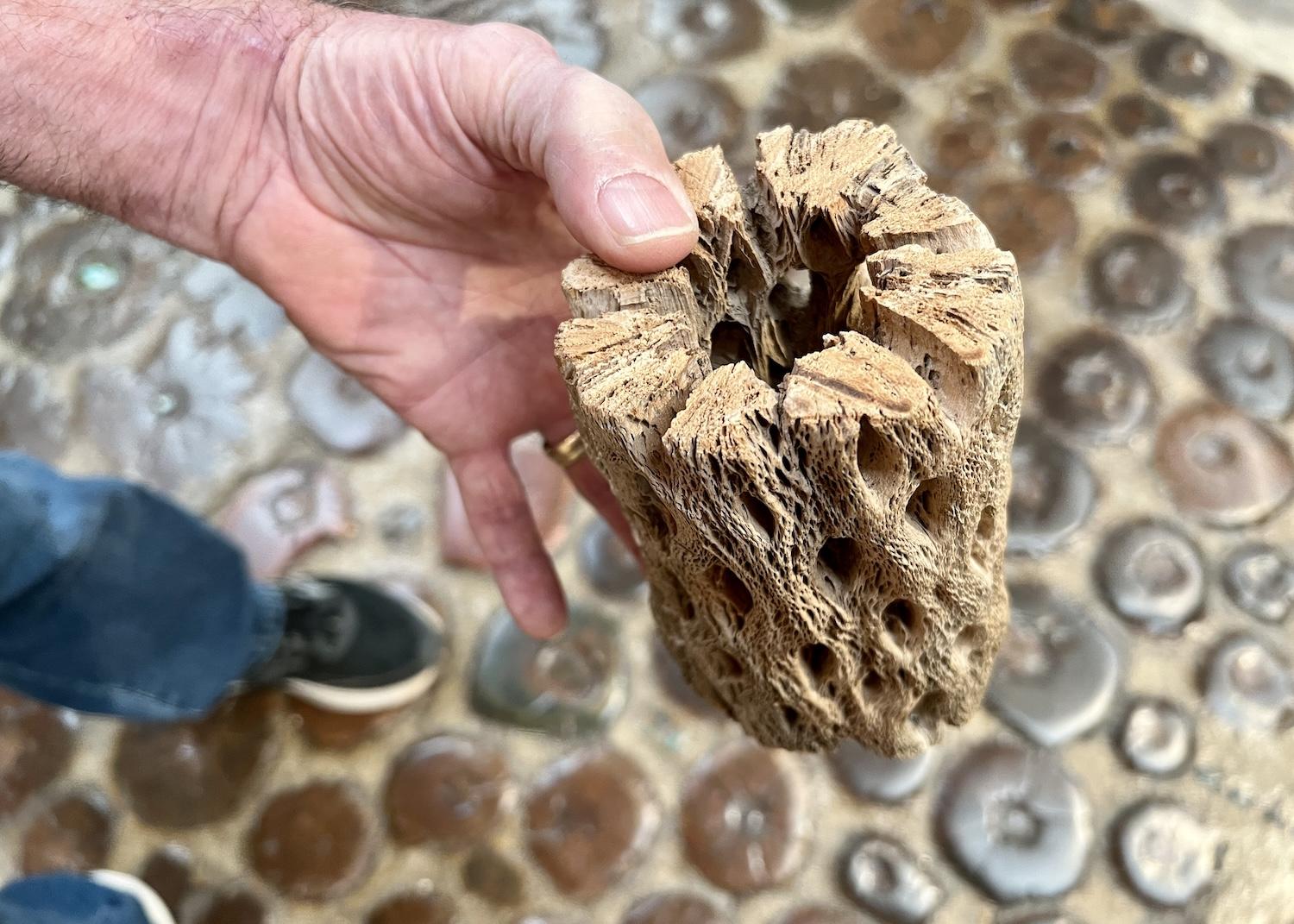
Artist Ted DeGrazia used cholla cactus pieces for a unique floor at DeGrazia Gallery in the Sun Museum/Jennifer Bain
It wasn't a saguaro floor, but the museum’s cholla floor was made by sealing four-inch pieces of that type of cactus in wax, painting their tops and embedding them in cement. The small section of homemade floor is deliberately uneven. “Well, life isn’t even,” DeGrazia famously said after he created the one-of-a-kind floor.
My room at the Loews Ventana Canyon Resort, about half an hour from Saguaro National Park's east district, looked over a saguaro-studded hill. There were saguaros along the hotel's short paved nature trail, and throughout the Ventana Canyon Trail I explored on my last morning with Barry Infuso, a retired culinary educator who leads hikes for the resort.
We lingered by one memorable saguaro skeleton where Infuso talked about artists Salvador Dalí and Georgia O’Keeffe and said this particular skeleton "just takes on a life of its own" when people look at it. Some see a cross, others see a bird. I saw the wizenend remains of a headless saguaro with three wilting arms that was as captivating in death as it must have been in life.
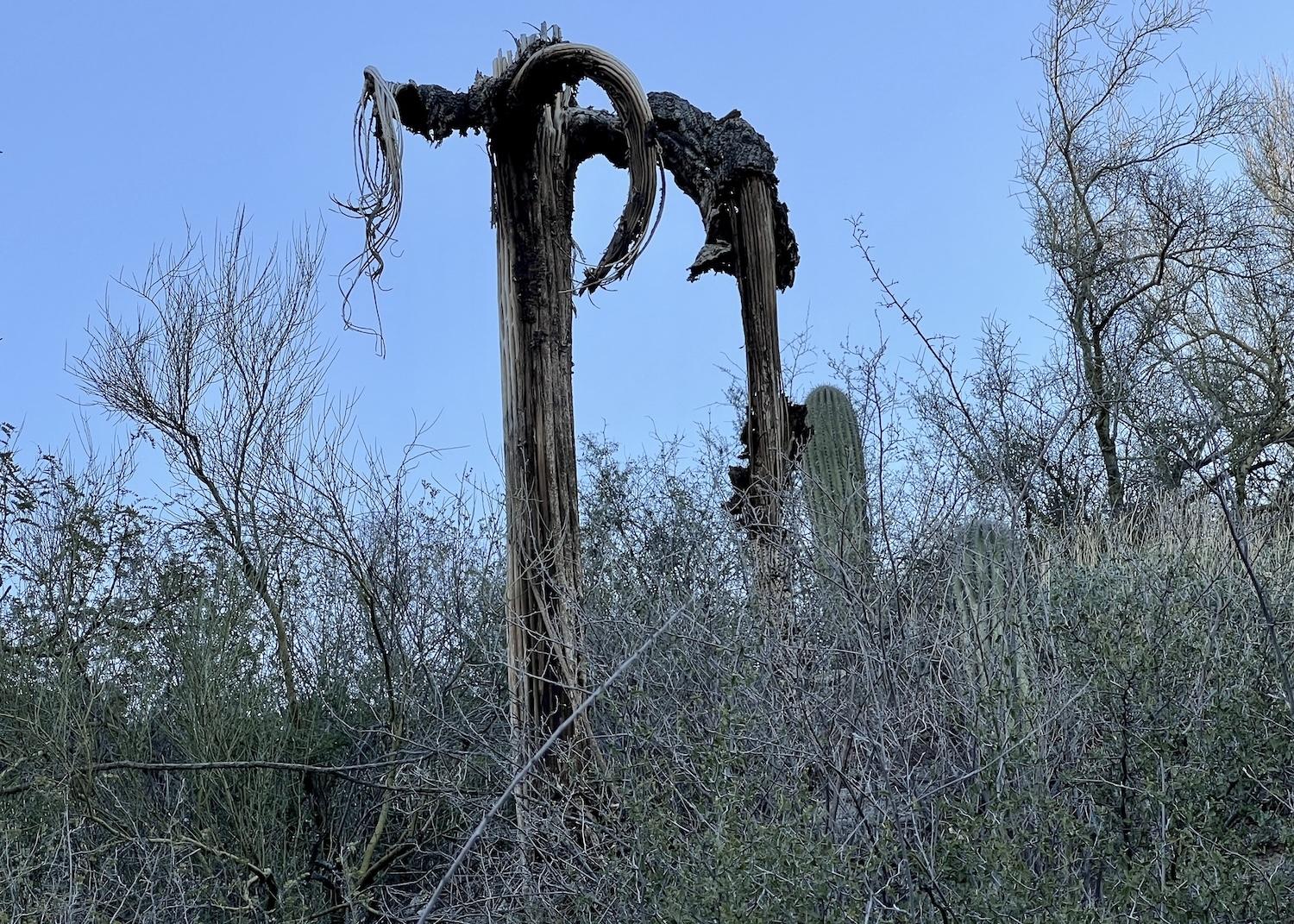
On the Ventana Canyon Trail, guide Barry Infuso from Loews Ventana Canyon Resort points out this striking saguaro skeleton/Jennifer Bain
